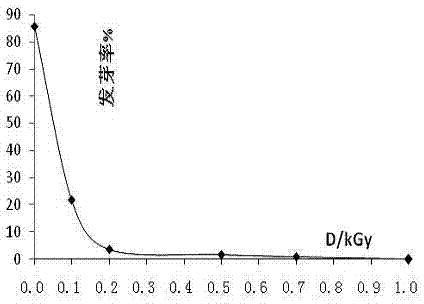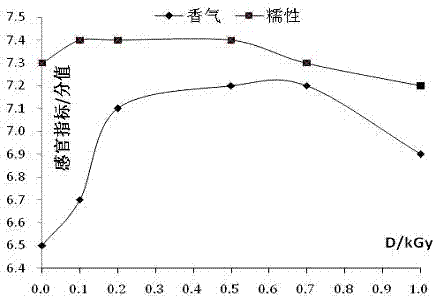Fresh dasheen preservation method
A taro and fresh technology, applied in the direction of preservation of fruits/vegetables through dehydration, preservation of fruits/vegetables through radiation/electrical treatment, etc., can solve the problems of difficult preservation, water loss, rot, etc., and reduce storage, transportation and sales losses, water loss, etc. The effect of reducing the loss of parts and increasing the commodity rate
- Summary
- Abstract
- Description
- Claims
- Application Information
AI Technical Summary
Problems solved by technology
Method used
Image
Examples
example 1
[0043] Jiangsu Jingjiang fragrant sand taro: Harvest, remove the soil, discard the rotten taro, and expose to the sun for 8 hours. Pack into polyethylene microporous bags, 1.0kg / bag. The above-mentioned small packaging bags are neatly stacked in cartons and sent to the irradiation field for irradiation treatment. The absorbed dose of the product is 0.2-0.25kGy. Irradiation was completed on the first day of harvest. Then store it indoors at 0-10°C. After 3 months, the germination rate of the taro is 0.5%. After tasting by the product quality personnel, the freshness, fragrance and waxiness of the taro are all good.
example 2
[0045] Jiangsu Jingjiang fragrant sand taro: Harvest, remove the soil, discard the rotten taro, and expose to the sun for 12 hours. Pack into polyethylene microporous bags, 2.0kg / bag. The above-mentioned small packaging bags are neatly stacked in cartons and sent to the irradiation field for irradiation treatment. The absorbed dose of the product is 0.3-0.39kGy. Irradiation was completed on the 4th day of harvest. Then place it in a room at 10-20°C for storage. After 3 months, the germination rate of the taro heads is 2.0%. After tasting by the product quality personnel, the freshness, fragrance and waxiness of the taro heads are all good.
example 3
[0047] Jiangsu Jingjiang fragrant sand taro: Harvest, remove the soil, discard the rotten taro, and expose to the sun for 16 hours. Put it into a polyethylene microporous bag, 3.0kg / bag. The above-mentioned small packaging bags are neatly stacked in cartons and sent to the irradiation field for irradiation treatment. The absorbed dose of the product is 0.4-0.5kGy. Irradiation was completed on the 7th day of harvest. Then place it in a room at 15-25°C for storage. After 3 months, the germination rate of the taro heads is 3.0%. After tasting by the product quality personnel, the freshness, fragrance and waxiness of the taro heads are all good.
PUM
| Property | Measurement | Unit |
|---|---|---|
| Aperture | aaaaa | aaaaa |
Abstract
Description
Claims
Application Information
 Login to view more
Login to view more - R&D Engineer
- R&D Manager
- IP Professional
- Industry Leading Data Capabilities
- Powerful AI technology
- Patent DNA Extraction
Browse by: Latest US Patents, China's latest patents, Technical Efficacy Thesaurus, Application Domain, Technology Topic.
© 2024 PatSnap. All rights reserved.Legal|Privacy policy|Modern Slavery Act Transparency Statement|Sitemap


